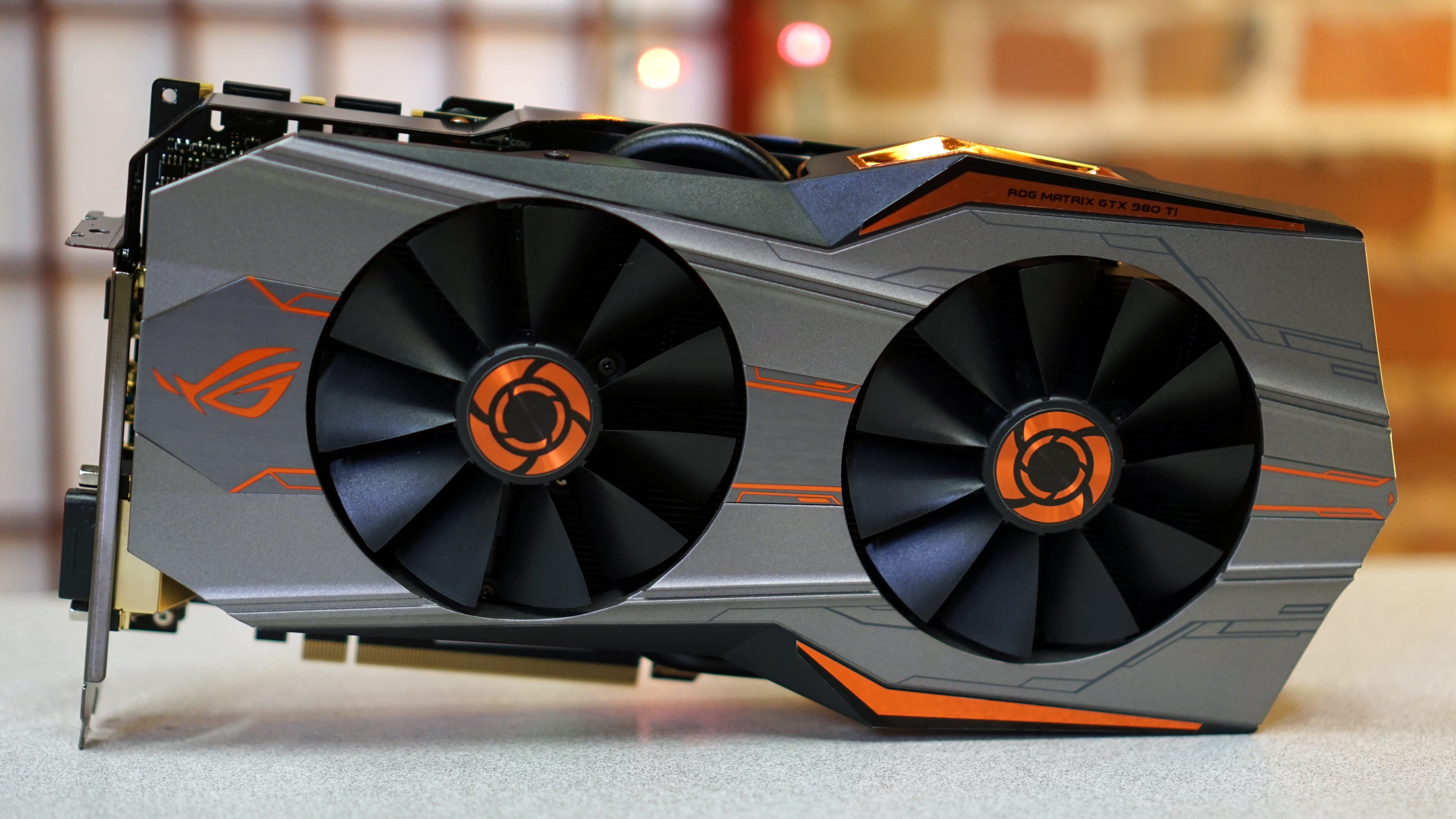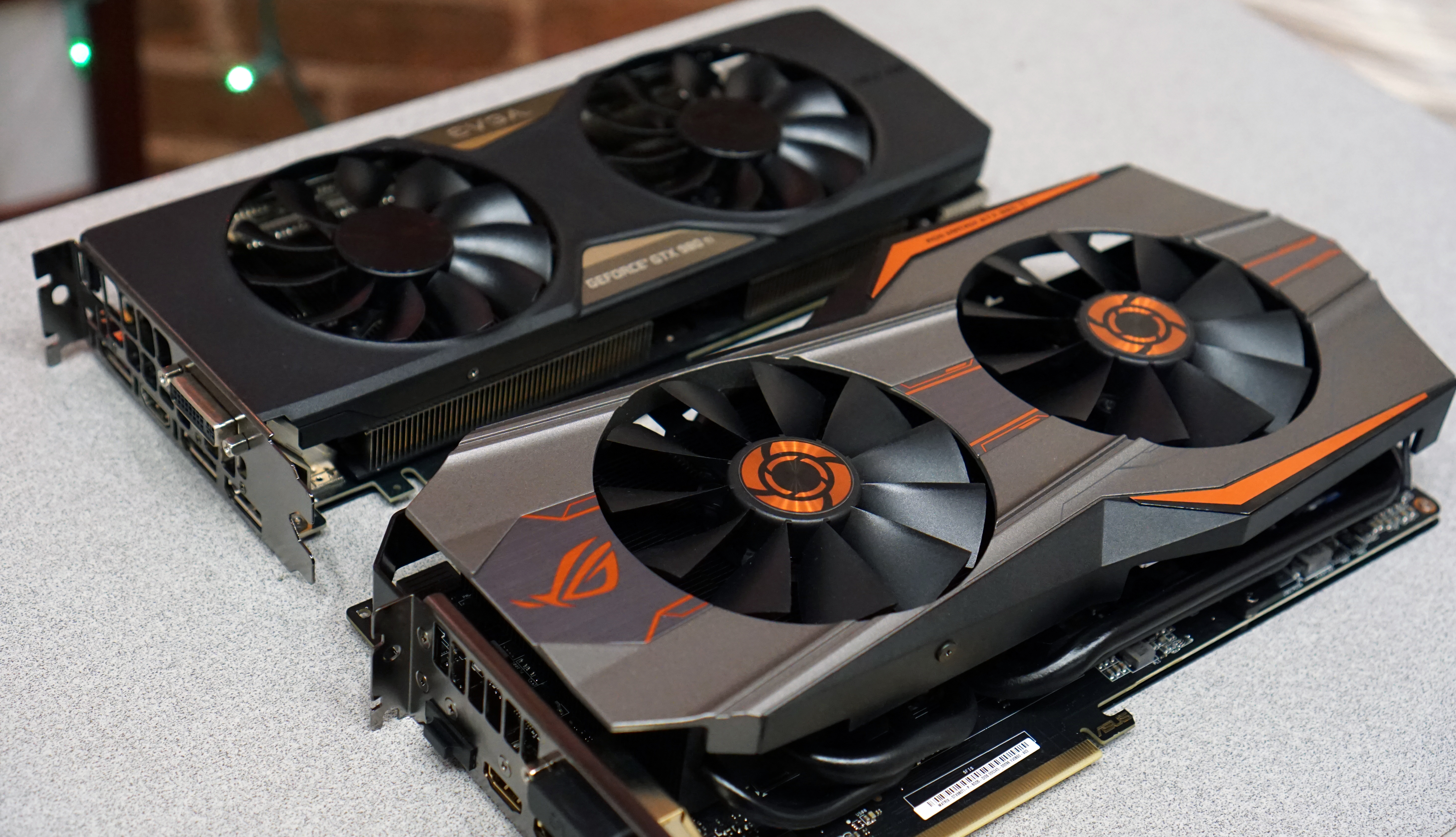The Asus Matrix squeezes a monstrous 1500 MHz out of the GTX 980 Ti

The reference Nvidia GTX 980 Ti is a powerhouse graphics card in an unassuming shell. Like the rest of Nvidia’s recent barebones cards, it has a simple silver body and a single fan that keeps it reasonably cool. Inside that body is a $650 card that can go toe-to-toe with the $1000 Titan X, but you wouldn’t know it by looking at it. It’s up to the hardware vendors to pimp out their own versions of these cards, with factory overclocks, special coolers and some flair that says “Look at me: I’m worth a lot of money.”
The Asus Matrix 980 Ti doesn’t just say “look at me: I’m worth a lot of money.” It screams it while flexing the graphics card equivalent of its biceps so hard it threatens to rip its shirt. The Matrix is Asus’s roided out top-end version of the 980 Ti, factory overclocked well beyond the average card with more headroom above that. And it’s a massive card by modern Nvidia standards, three slots wide and 11.5 inches long.
Unlike some oversized aftermarket cards that use all that space for three air coolers, the Matrix 980 Ti sticks with two fans and Asus’ tried-and-true DirectCU II copper heatpipe system. After spending some time testing the Matrix 980 Ti, I can imagine hardcore overclockers having a field day with this thing. It easily blew past my EVGA 980 Ti SC Gaming ACX 2.0, which is already overclocked at 1102 MHz (that’s 102 MHz faster than the reference card’s GPU) and turbos to 1190 MHz. Out of the box, the Matrix’s base clock is set at 1190 MHz and it turbos as high as 1317 MHz.
The Matrix also piles on features that you’ll never need in the average rig, like a memory defroster that will melt frost off the card at the touch of a switch (only significant for overclockers using liquid nitrogen to get really cold) and a VBIOS clear button that will reset the card to defaults in the case of an overclock gone awry.
To see what the Matrix 980 Ti could do on quick and dirty overclocking, I did some basic benchmarking on the EVGA SC Gaming and then used EVGA’s PrecisionX to adjust voltage, power, and clock speeds. I did the same with the Matrix 980 Ti and compared the results.

In the Tomb Raider benchmark, with everything maxed and SSAA cranked to 4x, EVGA’s card turned in an average 55.3 fps at 1440p. On the same settings, the Matrix 980 Ti delivered 61.3 fps. That was with no overclock on either card.
Motherboard: Gigabyte-X99-Gaming 5
CPU: Intel Core i7 5960X
Cooler: Enermax Liqtech 240 closed-loop liquid
RAM: 32GB Crucial DDR4-2133
Storage: Plextor M6e SSD, OCZ Vector 180 SSD
PSU: Enermax 1500 watt power supply
In GTA5, the EVGA card turned in an average of 35.9 fps at 1440p with every graphics setting and advanced graphics setting turned all the way up, including 8x MSAA. The Matrix again did a few frames better at 39.6 fps average.
The biggest gaming news, reviews and hardware deals
Keep up to date with the most important stories and the best deals, as picked by the PC Gamer team.
In the Unigine Heaven benchmark, there was a more pronounced difference: 48.8 fps for the EVGA, 56 fps for the Matrix 980 Ti.
Then came the overclocking. With about an hour of tinkering, I got the EVGA card to a stable overclock of +100 MHz on the GPU and +400 on the memory, with 56mv of extra voltage. That upped performance in the Heaven benchmark to an average 58.6 frames per second and a maxed turbo clock speed of 1433 MHz.
Do you think the Matrix 980 Ti could do better? You bet it could.
I managed to add 75 MHz to the GPU clock and 100 MHz to the memory speed on the Matrix, topping 1500 MHz, although the average fps was negligibly higher at 59.8.
Most impressively, both cards stayed comfortably cool. Even overclocked the Matrix hovered around 65C, and while the EVGA card ran much hotter at idle (around 50C with the fans not even running), it only got up to the low 70s under full load. And with the side panel off my case, I couldn’t hear either card unless I stuck my head right up to the system. Whisper quiet.
The Matrix 980 Ti is begging to be shown off in a flashy case with a window, assuming you dig Asus’s look. At $720, it’s priced at a premium over most 980 Tis; the EVGA card is only $650, and some of the Matrix’s features won’t mean much for you if you don’t obsess over every percent gained in manual overclocking.
Then again, you’re also paying for the convenience of this thing totally cruising out of the box. If money’s no object, you’re going to get a hell of a high performance card, no tuning required. Just make sure you have a case that can hold it.

Wes has been covering games and hardware for more than 10 years, first at tech sites like The Wirecutter and Tested before joining the PC Gamer team in 2014. Wes plays a little bit of everything, but he'll always jump at the chance to cover emulation and Japanese games.
When he's not obsessively optimizing and re-optimizing a tangle of conveyor belts in Satisfactory (it's really becoming a problem), he's probably playing a 20-year-old Final Fantasy or some opaque ASCII roguelike. With a focus on writing and editing features, he seeks out personal stories and in-depth histories from the corners of PC gaming and its niche communities. 50% pizza by volume (deep dish, to be specific).

